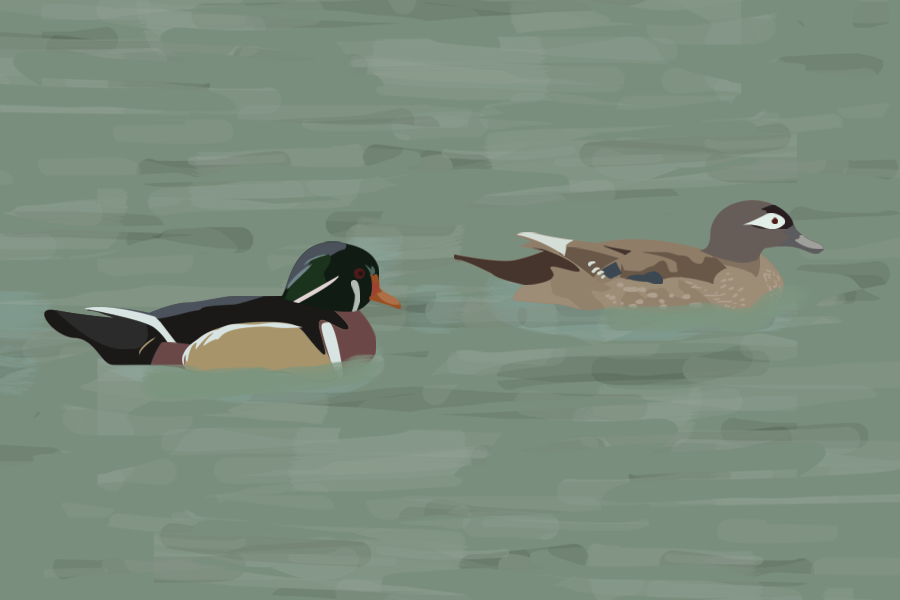
Conservation, preservation of nature flourishes in community effort
Davis is known for being a multifaceted college town filled with community-built treasures, the touch of local artists and a melting pot of different cultures. One of Davis’ assets is in tandem with the city’s environmental consciousness — the West Pond, located east of Lake Boulevard and north of Arlington Boulevard, has much to share with its surrounding community.
Jo Ellen Ryan and her husband Gene Trapp lead a group of volunteers called Friends of West Pond, a group of volunteers who work together to maintain the pond. With their help, the West Pond remains an intact wildlife habitat that visitors can actively enjoy.
“The Friends of West Pond was established to protect the area and protect the wildlife,” Ryan said. “A number of us residents decided to form this group, and the goal is really the conservation of local species.”
The Friends of West Pond have made great progress since its inception, and its milestones were acclaimed by a proclamation of official recognition from the City of Davis in 2016. One of its milestones includes creating a beautiful landscape along the previously empty walkway leading towards the pond.
“Almost 10 years ago, there was a blank space along the walkway,” Ryan said. “We planted a butterfly and hummingbird garden with informational plaques so people know what they are looking at.”
As a part of the effort toward keeping the pond thriving, the Friends must counteract many negative pressures, such as that of harmful invasive species. Two of the invaders the West Pond must face include starthistle and pepperweed.
“Students who come from agricultural areas would recognize the names of […the] pepperweed and starthistle,” Ryan said. “They’re not good in any landscape. They’re very invasive, and starthistle is dangerous to livestock.”
The Eurasian native Starthistle damages its new environment by crowding out native species, and is actually harmful to some livestock, such as horses. A part of the mustard family, the aggressive Pepperweed creates a dense single-species monopoly, spreading not only through seed production but also through vast creeping root systems.
It takes a grassroots community effort to root out these invaders, an effort students themselves can help perpetuate with their involvement. Ryan mentioned that students have the opportunity to take the wheel in building their own projects to come make a difference at the pond.
“We have had students do projects here and we’re always willing to talk with them and help them in any way,” Ryan said.
Despite its now lush landscape, West Pond started off as a storm water reservoir. Because of this, a lot of street trash drains into the pond, and the Friends take it upon themselves to go out into the pond and clean up the trash.
“Formally [the pond] is known as the West Area Drainage Pond,” Ryan said. “The pond was part of the [city] development because it was understood then that flooding was a potential problem. And so [the area] was dredged in order to hold storm water.”
The pond has been successful in attracting new visitors who enjoy the scenery in all its natural splendor.
“The UC Davis medical clinic and the Woodland clinic are at the north end of the pond,” Ryan said. “We noticed that many people that come for medical appointments, instead of getting back into their cars, come out and walk along the pond. I think it makes them just feel better.”
Sarah Mayhew is a professional photographer and a volunteer with the Friends of West Pond. She takes beautiful photographs of birds and other features of the pond, and often posts them on their Facebook page.
“[The pond] is a great wildlife area,” Mayhew said. “I live very close by, so I walk there all the time, and [that’s where] I met [Trapp] and [Ryan]. That’s how I started volunteer-gardening with them. Every wednesday a bunch of people get together and keep up the hummingbird garden. I specialize in bird photography now, and I help [Ryan] with the Facebook page.”
Keeping the pond in shape is an effort that requires the involvement of more people than may be anticipated.
“[Gene and Jo Ellen] stay in touch with the city and make sure that we get water in the pond if it starts going dry,” Mayhew said. “We are in touch with the city and the city biologist; it’s a kind of joint effort with everybody [in town].”
The winter season is a perfect time for students to pay the pond a visit, with all the rain bringing more liveliness to the habitat.
“We get a lot more rain in the winter, which brings a lot more ducks and birds,” Mayhew said. “It tends to be birdier with more water then, so the winter is a nice time to walk there.”
Ann Brice, who used to be the newsletter editor for the Yolo Basin Foundation and currently is a board member of the Yolo Audubon and Audubon California Societies, has worked closely with Gene and Jo Ellen to help publicize the West Pond and its events.
“I’ve known about West Pond and been involved with it for a long time,” Brice said. “When I was a grad student at UC Davis, I used to teach a course called ‘birds, humans and the environment,’ and we used to take field trips to the West Pond. That was a general education course, so it was just to try to get them interested in what’s going on in their own community.”
Whether it is to enjoy the nature walk, bike the trail, help with gardening and gain service credits, start a service project or photograph the wildlife, West Pond is just one Unitrans line away.
“People [who] go out there are interested in not just birds, but the plants, the butterflies and the environment in general,” Brice said.
Written by: Sahiti Vemula — features@theaggie.org



